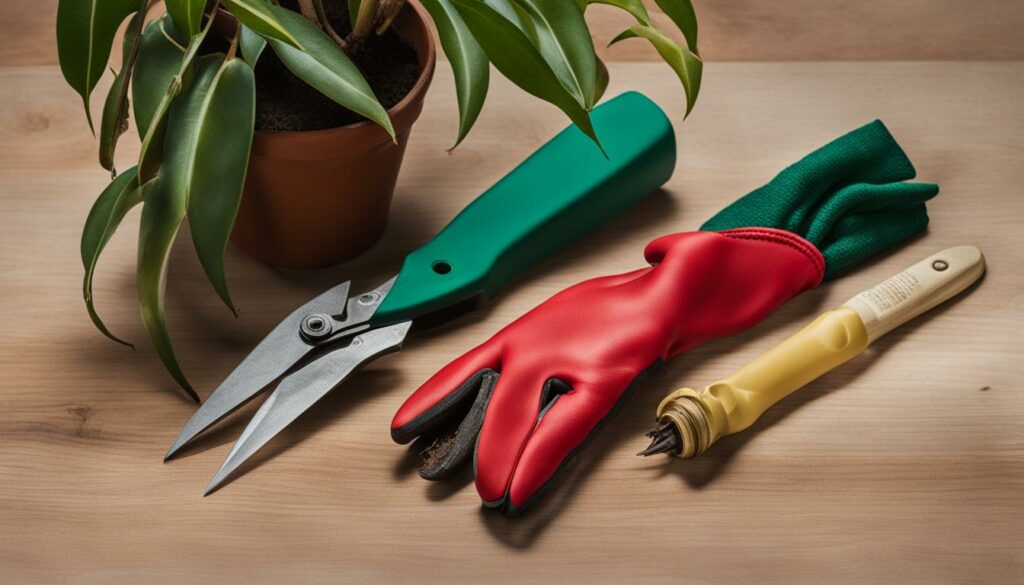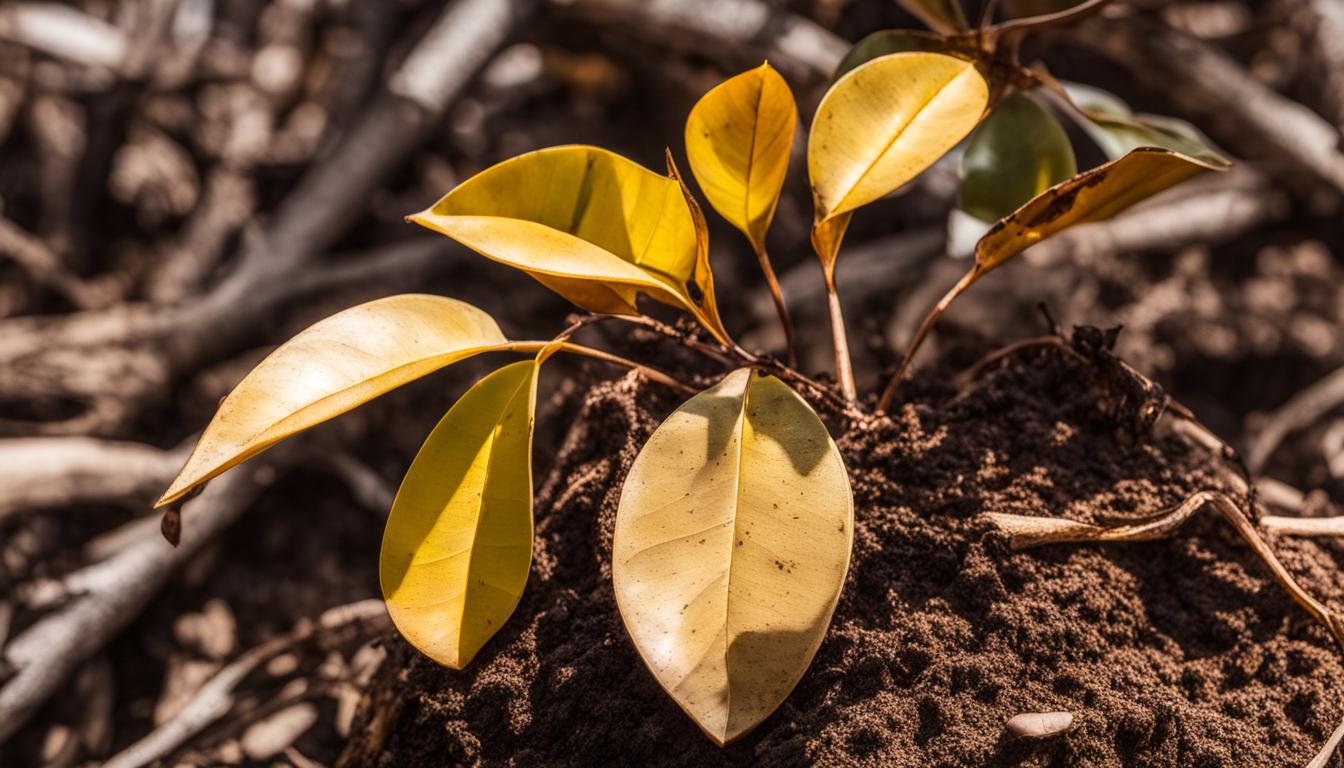I’m excited to share with you my Tineke Rubber Tree Care Guide. If you’re looking for tips on caring for your rubber tree plant, specifically the Tineke variety, you’ve come to the right place! Whether you’re a seasoned plant parent or just starting your plant journey, this guide will provide you with all the information you need to keep your Tineke Rubber Tree happy and thriving.
When it comes to rubber tree care, the Tineke plant requires attention to specific watering and light requirements. Additionally, pruning and propagation techniques are essential for maintaining its shape and size. I’ll also provide you with some helpful tips and troubleshooting advice to ensure your Tineke Rubber Tree stays healthy and vibrant. So let’s dive in and discover how to care for this beautiful and colorful houseplant!
Tineke Rubber Tree Watering and Light Requirements
In order to keep your Tineke Rubber Tree thriving, it is important to understand its specific watering and light requirements. By providing the right amount of water and ensuring proper lighting conditions, you can help your Tineke Rubber Tree grow and flourish.
Watering
The Tineke Rubber Tree prefers slightly moist soil, but overwatering should be avoided to prevent root rot. It is best to water the plant once a week, allowing the top 2-3 inches of soil to dry out before watering again. This ensures that the plant receives adequate moisture without becoming waterlogged.
Tip: When watering, be careful not to get water on the leaves, as it can stain them. Focus on watering the soil directly at the base of the plant.
Light Requirements
The Tineke Rubber Tree thrives in bright, indirect light. It should be placed a couple of feet away from a south- or west-facing window to avoid leaf scorching. Placing it in an east-facing window provides ideal lighting conditions. If you notice that your Tineke Rubber Tree’s leaves are turning yellow or brown, it may be an indication that it is not receiving enough light. Consider adjusting its placement to a brighter spot in your home.
| Watering | Lighting | |
|---|---|---|
| Frequency | Once a week | Bright, indirect light |
| Soil Moisture | Slightly moist | Allow top 2-3 inches of soil to dry out |
| Watering Technique | Water at the base, avoiding leaves | Avoid direct sunlight to prevent scorching |
| Lighting Placement | – | A couple of feet away from south- or west-facing window; ideal in east-facing window |
By following these watering and light requirements, you can ensure that your Tineke Rubber Tree receives the care it needs to thrive and add beauty to your home.
Tineke Rubber Tree Pruning and Propagation
Pruning is an essential part of caring for your Tineke Rubber Tree, as it helps maintain its shape and size. It is best to prune during the summer and spring when the plant is actively growing. Use sharp pruning shears or scissors to make clean cuts just above nodes, which are the areas where new growth sprouts. By pruning above nodes, you encourage the plant to produce new branches and leaves, keeping it looking its best.
To propagate your Tineke Rubber Tree, you have two options: air layering and cuttings. Air layering involves making a cut in the stem, about halfway through, and inserting a toothpick to keep the wound open. Then, wrap moist sphagnum moss around the cut and cover it with plastic wrap. After a few weeks, new roots will begin to grow. Once the roots are well-established, you can cut below the new root growth and plant the stem in fresh soil.
If you prefer to propagate through cuttings, simply select a healthy stem and cut it just below a node. Remove any lower leaves, leaving just a few at the top. Place the cutting in a pot with moistened all-purpose potting soil and keep it in a warm and humid environment. Within a few weeks, you should start to see roots forming. Once the roots are established, you can transplant the cutting into its own pot.
Table: Tineke Rubber Tree Pruning and Propagation Summary
| Propagation Method | Best Time | Process | Timeline |
|---|---|---|---|
| Air Layering | Summer and Spring | – Make a cut in the stem above a node – Insert a toothpick to keep the cut open – Wrap sphagnum moss around the cut – Cover with plastic wrap – Wait for new roots to grow – Cut below the new root growth and plant in fresh soil |
Approximately 4-6 weeks for roots to form |
| Cuttings | Anytime during the year | – Select a healthy stem and cut below a node – Remove lower leaves – Plant the cutting in moistened all-purpose potting soil – Keep in a warm and humid environment – Wait for roots to form – Transplant into its own pot |
Approximately 2-4 weeks for roots to form |
Tineke Rubber Tree Pruning and Propagation Tips
- Always use sharp and clean pruning shears or scissors to prevent damage or infection.
- When air layering, ensure the sphagnum moss remains moist throughout the process.
- For cuttings, mist the leaves regularly to maintain humidity.
- Provide bright, indirect light during the propagation process to promote healthy growth.
- Patience is key when propagating your Tineke Rubber Tree. It may take several weeks for roots to form, so be patient and continue to provide proper care.
Remember, pruning and propagation are important techniques to help your Tineke Rubber Tree thrive. By keeping up with regular pruning and experimenting with propagation methods, you can not only shape your plant but also create new plants to share with friends and family.

Tineke Rubber Tree Care Tips and Troubleshooting
When it comes to caring for your Tineke Rubber Tree, there are a few tips and tricks that can help keep your plant healthy and happy. First and foremost, dusting the leaves regularly with a microfiber cloth is essential to remove any buildup and keep the plant looking vibrant. Additionally, turning the plant periodically will ensure that all sides receive adequate light exposure. This can be done by rotating the pot a quarter turn every time you water the plant.
If you notice that the leaves of your Tineke Rubber Tree are losing their variegation and becoming dull in color, it may be a sign that the plant is not receiving enough light. In this case, consider moving it closer to a window or providing supplemental artificial lighting. On the other hand, if the leaves are turning yellow, it could indicate overwatering. Adjust the watering schedule accordingly to allow the soil to dry out more between waterings and ensure proper drainage.
“Proper care and attention will help your Tineke Rubber Tree thrive and maintain its stunning appearance.”
Another common issue that Tineke Rubber Tree owners may face is the presence of pests. Spider mites and aphids can infest the plant, causing damage to the leaves and overall health. To combat these pests, you can try spraying the plant with a mixture of water and mild soap or using a natural insecticide specifically formulated for houseplants. Regularly inspect your Tineke for any signs of infestation and take action promptly to prevent further damage.
Summary
By following these care tips and addressing any potential issues promptly, you can ensure that your Tineke Rubber Tree thrives and remains a beautiful addition to your indoor space. Remember to monitor the plant’s watering and lighting needs, dust the leaves regularly, and be on the lookout for any signs of pests. Proper care and attention will help your Tineke Rubber Tree thrive and maintain its stunning appearance.
Conclusion
In conclusion, proper maintenance is key for caring for the Tineke Rubber Tree. By following a few simple steps, you can ensure that your plant stays healthy and vibrant for years to come.
First and foremost, it is important to provide the Tineke with the right conditions for growth. This includes placing the plant in an area with bright, indirect light, and avoiding overexposure to direct sunlight. Additionally, maintaining a consistent watering schedule, allowing the top few inches of soil to dry out between waterings, will help prevent root rot and other water-related issues.
Regular pruning is also necessary to promote new growth and maintain the desired shape of the plant. Prune during the summer and spring seasons using sharp tools, making clean cuts above nodes.
Lastly, keep an eye out for any signs of trouble, such as yellowing leaves or pests, and take appropriate action. Regularly dusting the leaves with a microfiber cloth and turning the plant will also help keep it looking its best.
By following these maintenance tips and providing the Tineke Rubber Tree with the care it needs, you can enjoy a beautiful and thriving plant in your home for many years to come.
FAQ
How often should I water my Tineke Rubber Tree?
It is best to water the Tineke Rubber Tree once a week, allowing the top 2-3 inches of soil to dry out before watering again.
Where should I place my Tineke Rubber Tree?
The Tineke Rubber Tree loves bright, indirect light. It should be placed a couple of feet away from a south- or west-facing window to avoid leaf scorching. Placing it in an east-facing window provides ideal lighting conditions.
How do I prune my Tineke Rubber Tree?
Pruning the Tineke Rubber Tree is necessary to maintain its shape and size. It is best to prune during the summer and spring, using sharp tools to trim above nodes. This promotes new growth and keeps the plant looking its best.
How can I propagate my Tineke Rubber Tree?
The Tineke Rubber Tree can be propagated through air layering and cuttings. Air layering involves making a cut in the stem, inserting a toothpick to keep it open, and wrapping sphagnum moss around the cut. After new roots grow, the stem can be cut below the new root growth and planted in fresh soil. Cuttings can also be taken and planted in a pot with moistened all-purpose potting soil.
How do I troubleshoot common issues with my Tineke Rubber Tree?
If the leaves start losing their variegation in color, it may be an indication that the plant is not receiving enough light. Yellowing leaves can be a sign of overwatering, while crispy leaves with brown spots can indicate underwatering or too much sun exposure. Keeping an eye out for pests, such as mites or aphids, is also important for the health of the plant.



